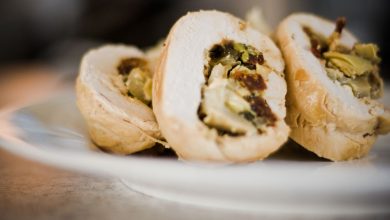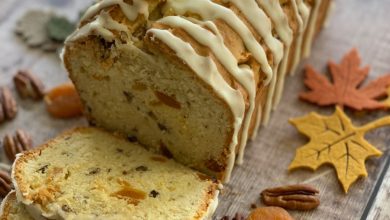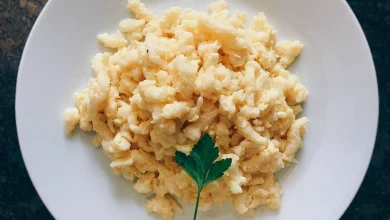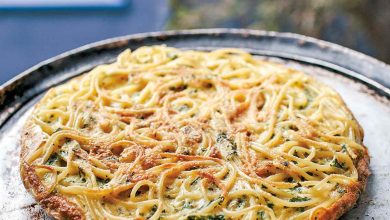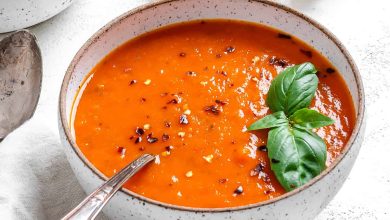Apricot Blancmange
Introduction
Deep within the rich tapestry of European culinary history lies a delicately refined dessert known as blancmange—a term that evokes images of opulence and tradition. Today, we explore a modern yet timeless variation: the Apricot Blancmange. This luscious treat combines the vibrant sweetness of ripe apricots with a smooth, velvety custard-like texture that is both comforting and sophisticated. Designed for lovers of fruity desserts and those seeking a versatile, elegant dish, Apricot Blancmange is perfect for special occasions or an indulgent afternoon snack. Lovewithrecipes.com proudly presents this comprehensive guide to creating a dessert that not only delights the palate but also offers a glimpse into centuries of culinary evolution, blending the old with the new in perfect harmony.
Time
Preparation of Apricot Blancmange involves multiple steps that require patience and precision. The entire process, from initial ingredient preparation to the final chilling, takes approximately 3 hours and 30 minutes. Here’s a breakdown:
- Initial Prep: 20-30 minutes
- Cooking and Mixing: 15-20 minutes
- Chilling Time: 2 to 3 hours (minimum)
Considering the need for thorough chilling to achieve the perfect set, plan your preparation accordingly to ensure optimal texture and flavor development.
Needed Equipment
Creating a perfectly silky Apricot Blancmange requires the right tools. Here is a comprehensive list to facilitate smooth preparation:
- Blender or Food Processor: For pureeing apricots to a smooth consistency.
- Measuring Cups and Spoons: To accurately measure ingredients.
- Mixing Bowls: For combining dry ingredients and preparing apricot purée.
- Heavy-bottomed Saucepan: Essential for heating milk and cooking the mixture evenly.
- Whisk or Wooden Spoon: To stir constantly and prevent lumps during cooking.
- Fine Mesh Sieve (optional): For straining the apricot purée if desired for a smoother finish.
- Ramekins or Molds: For setting the blancmange in individual servings or decorative shapes.
- Refrigerator: For chilling the dessert until perfectly set.
- Serving Plates or Dishes: For presentation of the final dish.
- Garnishing Tools: Such as a piping bag for whipped cream or a small spoon for garnishing with sliced almonds.
Tags
Elegant, Fruity, Classic, French-Inspired, No-Bake, Rich, Dessert, Summer, Kid-Friendly, Vegetarian, Gluten-Free (if using gluten-free thickeners)
Serving Size
Each serving of Apricot Blancmange is typically around ½ cup (120 ml). The recipe yields approximately 4 to 6 servings, depending on the size of your molds and portion preferences.
Difficulty Level
This recipe falls within the Intermediate category. It requires careful attention to heat and consistency, but is accessible for home cooks with basic culinary skills. Patience during the chilling phase is crucial for achieving the ideal texture.
Allergen Information
- Dairy: Contains milk, a primary ingredient.
- Potential Cross-Contamination: If prepared in a shared kitchen, consider allergen cross-contact.
- Gluten-Free: Naturally gluten-free, but verify ingredients if using pre-packaged thickeners or flavorings.
Dietary Preference
This dessert is suitable for:
- Vegetarian diets
- Gluten-free diets (if using gluten-free cornstarch)
- Vegan adaptation: Substitute dairy milk with plant-based alternatives such as almond or coconut milk, and use vegan gelatin or agar-agar as thickener.
Course
Sweet, Dessert, Fruit-Based, No-Bake
Cuisine
French-inspired, European, Classic European dessert
Ingredients
Ingredient Quantities and Details
| Ingredient | Quantity | Notes |
|---|---|---|
| Ripe apricots | 2 cups (about 6-8 apricots) | Fresh or frozen; choose ripe for sweetness |
| Granulated sugar | ½ cup (100 g) | Adjust based on apricot sweetness |
| Cornstarch | ¼ cup (30 g) | For thickening |
| Milk | 2 cups (480 ml) | Whole milk recommended for creaminess |
| Vanilla extract | 1 teaspoon | Pure vanilla for depth of flavor |
| Salt | A pinch | Enhances sweetness |
| Whipped cream (optional) | For garnish | Homemade or store-bought |
| Sliced almonds (optional) | For garnish | Adds crunch and presentation appeal |
Instructions
Step 1: Preparing the Apricots
Begin by selecting ripe apricots. Ripe apricots are slightly soft to the touch and have a fragrant aroma. Wash them thoroughly under cold running water to remove any dirt, pesticides, or residues. Using a paring knife, carefully pit the apricots, removing the stones while preserving the flesh. If you prefer a smoother texture, you can peel the apricots by blanching them in boiling water for 15-20 seconds, then plunging into ice water—this makes the skin easier to peel. However, leaving the skin on adds color and nutrients.
Step 2: Making the Apricot Purée
Place the pitted apricots into a blender or food processor. Blend until completely smooth, ensuring there are no chunks remaining. For an even finer texture, you can pass the purée through a fine-mesh sieve, pressing with the back of a spoon to extract maximum smoothness. Measure out approximately 1½ cups of apricot purée; discard any excess or save for another recipe, such as smoothies or jams.
Step 3: Mixing Dry Ingredients
In a small bowl, combine the granulated sugar and cornstarch. Whisk together thoroughly to prevent lumps. This step ensures even distribution of thickening agents during cooking, resulting in a silky smooth blancmange.
Step 4: Heating the Milk
Pour the milk into a heavy-bottomed saucepan. Place over medium heat and warm gently, stirring constantly to prevent scorching. You want the milk to reach a temperature of about 140°F (60°C), just before boiling—this ensures it’s hot enough to incorporate the thickening ingredients but not boiling over. Once warm, add the sugar and cornstarch mixture gradually, whisking vigorously to prevent clumps from forming.
Step 5: Cooking the Mixture
Continue to cook over medium heat, stirring constantly. The mixture will start to thicken as the cornstarch activates. Keep stirring until it reaches a pudding-like consistency, approximately 5-7 minutes. Be attentive to prevent burning or lumps formation. Adjust heat as needed to maintain a gentle simmer, not a rapid boil.
Step 6: Incorporating Apricot Purée and Flavors
Remove the saucepan from heat once the mixture is thickened. Stir in the apricot purée, vanilla extract, and a pinch of salt. Mix thoroughly to ensure an even distribution of flavor and color. The apricot purée not only adds flavor but also gives the blancmange a beautiful orange hue that is visually appealing.
Step 7: Pouring into Molds
Divide the mixture evenly among your chosen ramekins or molds. Use a ladle or pouring jug for precision. Smooth the tops with the back of a spoon or a small spatula. Cover each mold with plastic wrap or foil to prevent a skin from forming during chilling.
Step 8: Chilling and Setting
Place the molds into the refrigerator. Allow the blancmange to set for at least 2 hours, ideally 3 hours or overnight for a firmer texture. The chilling process allows the cornstarch to fully gelatinize, giving the dessert its characteristic smooth and tender consistency.
Step 9: Serving and Garnishing
Once set, you may choose to unmold the blancmange by dipping the molds briefly in warm water, then inverting onto serving plates. Alternatively, serve directly from the molds for a rustic presentation. Garnish with whipped cream and sliced almonds for added texture and visual appeal. Fresh apricot slices or a drizzle of apricot syrup can also enhance presentation and flavor.
Preparation Tips
- Use ripe, fragrant apricots for the best flavor and color.
- If you prefer a more intense apricot flavor, increase the purée slightly or add a splash of apricot liqueur.
- Constant stirring during cooking is crucial to avoid lumps and scorching.
- For a dairy-free version, substitute milk with almond milk or coconut milk, and use agar-agar as a thickening agent instead of cornstarch.
- For a more vibrant color, add a few drops of natural food coloring or a squeeze of fresh lemon juice to brighten the hue.
Nutritional Information
| Nutrient | Per Serving (½ cup) | Remarks |
|---|---|---|
| Calories | 220-250 kcal | |
| Total Fat | 3-5 g | |
| Saturated Fat | 2-3 g | |
| Cholesterol | 10-15 mg | |
| Sodium | 70-100 mg | |
| Total Carbohydrates | 45-50 g | |
| Sugars | 30-35 g | |
| Dietary Fiber | 1-2 g | |
| Protein | 4-6 g |
Tips and Tricks
- For a more intense apricot flavor, simmer the apricots with a splash of water and a touch of honey before blending.
- Adjust sweetness by varying the sugar content; taste the mixture before chilling.
- Using a silicone mold can make unmolding easier and more visually appealing.
- Chill the blancmange uncovered initially, then cover with plastic wrap to prevent it from absorbing other fridge odors.
- Experiment with flavor variations by adding a hint of cinnamon or cardamom for a warming aroma.
Add-ons
- Fresh mint leaves for a refreshing contrast.
- Drizzle of honey or apricot syrup for added sweetness and shine.
- Chocolate shavings or a dusting of cocoa powder for a decadent twist.
- Fresh berries as a tart complement to the sweet apricot flavor.
Side Dishes
Pair the Apricot Blancmange with light, complementary sides such as:
- Fresh fruit salad with citrus segments.
- Light vanilla or almond cookies.
- Herbal or floral teas, such as chamomile or jasmine.
- Whipped cream or mascarpone for extra richness.
- Crunchy biscotti or almond tuilles for textural contrast.
Improvements
- Incorporate natural fruit extracts like peach or apricot essences for enhanced flavor.
- Use high-quality vanilla beans or vanilla bean paste for a richer aroma.
- Experiment with different thickening agents like gelatin or agar-agar for different textures.
- Infuse the milk with herbs such as basil or thyme for subtle aromatic layers.
- Adjust the sugar level to suit dietary needs or sweetness preferences.
Save and Store
Store any leftovers in an airtight container in the refrigerator for up to 2 days. For best results, cover the surface of the blancmange to prevent it from drying out or absorbing fridge odors. To reheat, gently warm in a water bath or microwave, then serve chilled or slightly warmed. Avoid freezing, as the texture may become compromised upon thawing.
FAQ
Can I make this dairy-free?
Absolutely. Replace cow’s milk with plant-based alternatives like almond, coconut, or soy milk. Use agar-agar or vegan gelatin for thickening instead of cornstarch. The flavor will be slightly different but equally delicious.
Can I add other fruits?
Yes. Mango, peach, or berry purées can be blended into the mixture for additional flavor layers. Adjust sweetness accordingly, as different fruits have varying sugar levels.
Is it suitable for children?
Yes. This dessert is generally kid-friendly, especially if made with natural sweetness and no added artificial flavors. Garnishing with whipped cream and sliced almonds makes it visually appealing and tasty for children.
How can I unmold the blancmange easily?
Briefly dip the molds in warm water (not hot) for a few seconds, then invert onto serving plates. This helps release the dessert without breaking the delicate structure.
Conclusion
Apricot Blancmange embodies a harmonious balance between fruity brightness and creamy elegance, making it an impeccable choice for a refined dessert experience. Its history, versatility, and simple elegance allow for creative variations that can be tailored to any palate or occasion. Whether served at a festive gathering or enjoyed as a comforting treat, this dessert’s delicate texture and vibrant flavor encapsulate the art of French-inspired patisserie. Remember to take your time during preparation, allowing flavors to meld and textures to set, resulting in a dessert that is as stunning as it is delicious. Lovewithrecipes.com invites you to indulge in this sweet journey, celebrating the timeless allure of apricots and the classic charm of blancmange.
References
- Wikipedia: Blancmange
- Larousse Gastronomique, The New Encyclopedia of Food, Wine & Cookery

